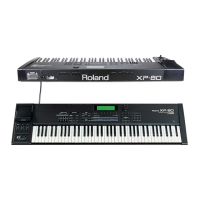®ÂØÒňÎ
®
XP-60/80
Music Workstation
Supplemental
Notes
June 24, 1998
© 1998 Roland Corporation U.S. XP-60/80 Advanced Sequencing Page 1 of 9
Advanced Sequencing on the XP-60 and XP-80
This document expands on the original “Basic Sequencing for the XP-80” Supplemental Notes (which can also be
applied to the XP-60). If you would like to order the Basic Sequencing document, please call our Faxback system at
(323) 685-5141 ext. 271 and order document # 21016, or download the file from our Website:
www.rolandus.com.
First, we will cover Patterns and using the RPS function. Next, the Track Edit functions will be examined followed by
the Quantize function. We will then look at the Microscope Edit mode followed by a section on using the Controllers
(C1, C2, Pedals, etc). Finally, we will give some useful ideas to bring all of the XP-60 and XP-80’s power together
for your sequences. Please note that the XP-60 and XP-80 are functionally identical and all procedures apply to
either instrument.
I. Patterns
As we saw in the Basic Sequencing Supplemental Notes, the sequencer section in the XP-60/80 has sixteen
Phrase tracks for recording. The XP-60/80 also allows you to record up to 100 Patterns per song (up to 99 bars
each). A Pattern contains a single track that can record on up to 16 MIDI channels. Patterns do not have a
Tempo or Beat track as the Phrase tracks do. This means that you can not change the tempo or time signature in
the middle of a Pattern. Patterns can be used for sections of a song, repetitious parts, or for editing data in
Phrase Tracks. They can also be used for the Realtime Phrase Sequencing (RPS) function. Use the following
procedure to record a 4 bar sequence in Pattern 001:
First, we need to select a Performance. We will select “Preset A-12: Pop Set 1” as it is a good starting point for
sequencing. By simply choosing this Performance, we are setting specific Patches to play on each MIDI channel:
1) Press PERFORMANCE.
2) Use the VALUE DIAL to select Performance “PR-A: 12 Pop Set 1.”
Now we will record a Pattern with a drum, bass, and piano part:
1) Press SEQUENCER.
2) Press RECORD so it is lit.
3) Press the PATTERN button and use the VALUE DIAL to select Pattern 001.
4) CURSOR to Tempo and use the VALUE DIAL to select the desired tempo (120 BPM is the default).
5) CURSOR to Loop and use the VALUE DIAL to select “4.” This will set up a four measure pattern.
6) CURSOR to Mode and use the VALUE DIAL to select “MIX.”
7) CURSOR to Qntz and use the VALUE DIAL to select “OFF.”
8) CURSOR to Count In and use the VALUE DIAL to select “1.”
9) CURSOR to Part and use the VALUE DIAL to select Part 10. We will record the drum part first.
10) Press PLAY to begin recording. Record a drum pattern with a sixteenth-note feel. You can continue to add
parts as the sequencer loops every 4 bars.
11) Use the VALUE DIAL to select Part 2 for bass and record a bass part.
12) Use the VALUE DIAL to select Part 1 for piano and record a piano part.
13) Press STOP.
Now let’s set up our four bar Pattern to loop:
1) Press F5 (LOOP).
2) CURSOR to Repeat and use the VALUE DIAL to select “INFINIT.”
3) CURSOR to Start and use the VALUE DIAL to select “1-01-000” (the beginning of our Pattern).
4) CURSOR to End and use the VALUE DIAL to select “5-01-000” (the end of our Pattern).
5) Press EXIT.
6) Press LOOP so it is lit.
7) Hold SHIFT and press BWD to rewind. Press PLAY to play the Pattern.

